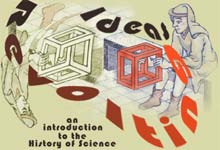
University of California, Irvine
Instructor: Dr. Barbara J. Becker

|
|
Worldviews of the Ancient Greeks |
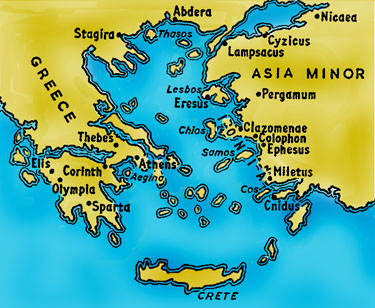
The Greek World
|
|
The Ionians |
|
Parmenides of Elea (c. 480 BCE) |
|
What is, IS--and cannot NOT BE. Something that IS cannot become what it IS NOT. Conundrum: If there is only ONE first principle, how can we account for the diversity we observe in the world?
"...it is right that you should learn all things, both the persuasive, unshaken heart of Objective Truth (The Way of Truth), and the subjective beliefs of mortals (The Way of Seeming), in which there is no true trust. But you shall learn these too: how, for the mortals passing through them, the things-that-seem must 'really exist,' being, for them, all there is."
|
Responses to Parmenides' Challenge |
|
Anaxagoras (500-428 BCE) There are as many elements as there are things that exist. Empedocles (490-430 BCE) Agents of love and strife (attraction and repulsion) act on 4 elements (earth, air, fire, water) to produce diversity observed in the world. We can know about the world because we are made of these elements. Atomists (460-370 BCE) e.g. Leucippus, Democritus There is only one element--That Which Is (Atoms). But That Which Is Not is also real (the Void). Atoms and the Void interact (through random motion and collisions) thus producing all the diversity observed in the world. We can know about the world through our senses when atoms impinge on us. |
The Athenians |

The School of Athens (1509-1511),
by Raphael [Raffaello Sanzio (1483-1520)]
Socrates (470-399 BCE) Marked end of ancient thinking and beginning of progressive classical Greek thought. After Peloponnesian War (431-404 BCE), Athenians faced political crisis: How is the state to be governed?
Cosmos and Polis are related: use methods for obtaining knowledge of the natural world to gain better understanding of and mastery over human affairs. |
Two worlds:
Mathematics (geometry) bridges these two worlds and makes the Ideal world accessible to human understanding through reason.
|
||||||||||||
Quadrivium
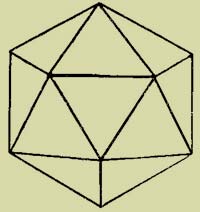 |
||||||||||||
Plato's "Likely Story" about the Structure and Substance of the Natural World
|
||||||||||||
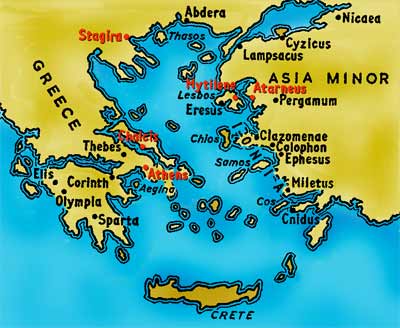
Events in the Life of Aristotle (384-322 BCE) |
|
| 384 BCE | born in Stagira |
| c. 366 | began studies with Plato at the Academy in Athens |
| c. 347 | after Plato's death, joined his former student, Hermeias, in Atarneus where they formed a group patterned after the Academy |
| c. 343 | moved to Mytilene on the island of Lesbos |
| c. 342 | invited back to Stagira to serve as tutor to Alexander, the 13-year-old son of Philip of Macedon |
| c. 334 | returned to Athens, where he established the Lyceum, his own philosophic circle |
| c. 323 | after Alexander's death, fled Athens and settled in Chalcis on the island of Euboea |
| 322 BCE | died after a brief illness |
Treatises Attributed to Aristotle |
|
Logic -- What, how and why of reason
|
|
Inanimate things -- What, how and why of the material world
|
|
Animate things -- What, how and why of living things
|
|
Philosophy -- What, how and why of social interaction
|
|
| Aristotle's Critique of Plato |
|
Postulating the existence of two worlds (Real and Ideal) --
Mathematics --
Living things --
|
| All matter is made of two parts:
hyle (HOO-lee)--basic fundamental stuff
Tension and balance generated by opposing qualities (wet vs. dry; cold vs. warm) is behind all change observed in terrestrial world.
|
|||||||||||||
Aristotle's First Principles |
|||||||||||||
| Arché | motion (not a material substance)
• change of state (growth, decay, death, size, shape...) • change of position |
||||||||||||
| Physis | opposition • cold vs hot • wet vs dry |
||||||||||||
Physics of the Celestial realm |
|||||||||||||
|
The celestial element (quintessence) has no opposing qualities.
|
|||||||||||||
Physics of the Terrestrial realm |
|||||||||||||
|
Each terrestrial element (earth, water, air, fire) has a natural place or state.
|
|||||||||||||
To know a thing is to understand four basic things which cause it to be as it is:
|
|||||||||||||
Hellenistic Period (323-31 BCE) |
|
After the death of Alexander (356-323 BCE):
|
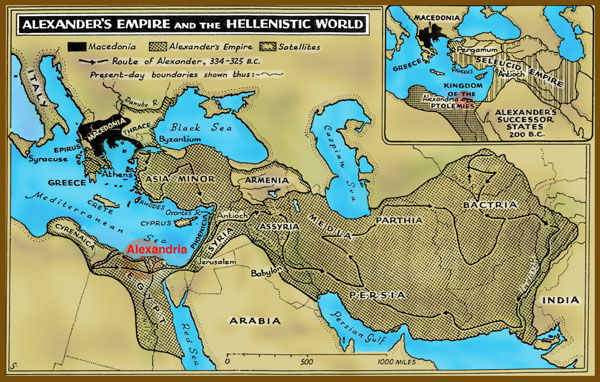
|
(Hellenistic Period--Greek influence)
________________ (Roman Empire--Greeks)
|
________________ |
|
Roman Empire--Romans
|
|